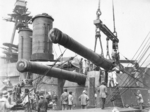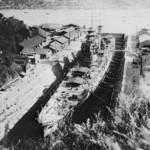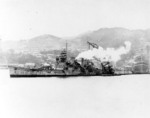Mitsubishi Nagasaki Shipyard
| Type | 196 Shipyard | |
| Historical Name of Location | Nagasaki, Nagasaki, Japan | |
| Coordinates | 32.738997000, 129.856400000 |
Contributor: C. Peter Chen
ww2dbaseWorking with a group of Dutch engineers, the Tokugawa Shogunate of Japan created a foundry in Nagasaki, near the southwestern tip of the Japanese home islands, in 1860, with the eventual aim of domestic shipbuilding. In 1868, it was nationalized and was placed under control of the Nagasaki Prefectural Government. In 1879, the No. 1 Drydock was completed. In 1884, Yataro Iwasaki founded the firm Nagasaki Shipyard and Machinery Works. In 1887, Iwasaki purchased the entire Nagasaki facilities complex from the government. In 1903, it was renamed Mitsubishi Shipyard of Mitsubishi Goshi Kaisha. In 1896, the No. 2 Drydock was completed at Akunoura. In 1903, the No. 2 and No. 3 Building Berths were completed; by 1906, all 8 berths would be completed. In 1905, the No. 3 Drydock was completed at Iwasedo. In 1907, the facility completed Japan's first experimental tank for shipbuilding. In 1908, the main power station was completed; it was Japan's first power generating turbine. In 1912, the gantry crane was completed at the No. 1 Building Berth. In 1917, it was renamed Mitsubishi Shipbuilding and Engineering Company, Limited. In 1934, it was renamed once again as Mitsubishi Heavy Industries. In 1936, the gantry crane was completed at the No. 2 Building Berth. In 1937, the foundry was separated from Mitsubishi Heavy Industries as the Nagasaki Steel Works of Mitsubishi Steel Manufacturing Company, Limited. In 1939, all 8 building berths would be equipped with gantry cranes.
ww2dbaseBy the late 1930s, the Mitsubishi conglomerate in its entirety had become the largest private firm in Japan, and its Nagasaki shipbuilding facility was a major shipbuilder for the Japanese Navy. The facility's most well known product was the battleship Musashi, which, alongside of sister Yamato, was the largest battleship ever built. Musashi was launched in utmost secrecy in Nov 1940, and was commissioned into service in Aug 1942. During the war, the Nagasaki facility also constructed special attack submarines and boats for suicide missions. Due to the industrial importance, the city of Nagasaki was attacked by convention bombs five times starting in Aug 1944. The fifth conventional raid, dated 1 Aug 1945, targeted, among others, the shipyard. The presence of the shipyard certainly factored intofoundrdy the decision for Nagasaki to be placed on the target list for atomic bombing.
ww2dbaseAfter the war, Mitsubishi was divided into three companies, and the Nagasaki facility became West Japan Heavy Industries, Limited. In 1952, it was renamed Mitsubishi Shipbuilding and Engineering Company, Limited. In 1963, No. 1 Drydock was demolished after 84 years of operations in order to create space for the construction of new drydocks. In 1964, the three companies merged together once again, forming Mitsubishi Heavy Industries, Limited, and the Nagasaki facility was renamed Nagasaki Shipyard and Engine Works. In 1965, two 300,000-ton dry docks were completed. It would continue to evolve, launching ships of various sizes, including several very large luxury cruise liners. Mitsubishi Heavy Industries is still conducting shipbuilding and repairing operations at Nagasaki at the time of this writing.
ww2dbaseSources:
Mitsubishi Heavy Industries
Nagasaki National Peace Memorial Hall
Wikipedia
Last Major Update: Sep 2018
Ships Constructed at Mitsubishi Nagasaki Shipyard
| Ship Name | Yard No | Slip/Drydock No | Ordered | Laid Down | Launched | Commissioned |
| Kinai Maru | ||||||
| Soya | 16 Feb 1937 | |||||
| Kirishima | 17 Mar 1912 | 1 Dec 1913 | 19 Apr 1915 | |||
| Hyuga | 16 May 1915 | 27 Jan 1917 | 30 Apr 1918 | |||
| Kiso | 10 Aug 1918 | 10 Feb 1920 | 29 Jan 1921 | |||
| Tama | 10 Aug 1918 | 10 Feb 1920 | 29 Jan 1921 | |||
| Natori | 14 Dec 1920 | 16 Feb 1922 | 15 Sep 1922 | |||
| Kamikaze | 15 Dec 1921 | 25 Sep 1922 | 19 Dec 1922 | |||
| Sendai | 16 Feb 1922 | 30 Oct 1923 | 29 Apr 1924 | |||
| Furutaka | 5 Dec 1922 | 25 Feb 1925 | 31 Mar 1926 | |||
| Haguro | 16 Mar 1925 | 24 Mar 1928 | 25 Apr 1929 | |||
| Asama Maru | 10 Sep 1927 | 30 Sep 1928 | 15 Sep 1929 | |||
| Tatsuta Maru | 3 Dec 1927 | 12 Apr 1929 | 15 Mar 1930 | |||
| Mikuma | 27 Oct 1931 | 31 May 1934 | 29 Aug 1935 | |||
| Chikuma | 1 Oct 1935 | 19 Mar 1938 | 20 May 1939 | |||
| Kaiyo | 5 Feb 1938 | 9 Dec 1938 | 23 Nov 1943 | |||
| Musashi | 29 Mar 1938 | 1 Nov 1940 | 5 Aug 1942 | |||
| Unyo | 751 | 14 Dec 1938 | 31 Oct 1939 | 31 May 1942 | ||
| Junyo | 20 Mar 1939 | 26 Jun 1941 | 3 May 1942 | |||
| Taiyo | 6 Jan 1940 | 19 Sep 1940 | 2 Sep 1941 | |||
| Awa Maru | 10 Jul 1941 | 24 Aug 1942 | 5 Mar 1943 | |||
| Amagi | 1 Oct 1942 | 15 Oct 1943 | 10 Aug 1944 |
Mitsubishi Nagasaki Shipyard Interactive Map
Photographs
 |  |  |  |
Mitsubishi Nagasaki Shipyard Timeline
| 7 Jul 1884 | The firm Nagasaki Shipyard and Machinery Works was founded by Yataro Iwasaki in Nagasaki, Japan. The firm would operate the government-owned shipyard at Nagasaki; the firm would purchase the shipyard from the government three years later. |
| 15 Dec 1921 | The keel of Destroyer No. 1 was laid down by the Mitsubishi Shipbuilding and Engineering Company in Nagasaki, Japan. |
| 18 Dec 1921 | The 40,000-ton battleship Tosa was launched by Mitsubishi at Nagasaki, Japan. Intended to be one of the second pair of high-speed battleships under the 8-8 programme, she would be cancelled before completion by the Washington Treaty and eventually scuttled on 9 Feb 1925. |
| 25 Sep 1922 | Destroyer No. 1 was launched at the Mitsubishi shipyard in Nagasaki, Japan. |
| 3 Dec 1927 | The keel for ship numbered 451 was laid down at Mitsubishi Shipbuilding's yard at Nagakaki, Japan. |
| 12 Apr 1929 | Ship number 451 of Mitsubishi Shipbuilding's Nagasaki Yard in Japan was launched and named Tatsuta Maru. |
| 29 Jul 1945 | 32 US A-26 aircraft attacked Nagasaki, Japan between 1000 and 1200 hours, dropping 51 tons of bombs and 6 tons of fragmentation bombs. The main target were the industrial facilities on the water. The ship fitting factory at the Mitsubishi shipyard was totally destroyed; several other industrial facilities nearby were also damaged. Merchant ship Sansui Maru No. 5 was sunk at its mooring at Akunoura. The attack also destroyed a 20-meter stretch of street car tracks, damaged the Nagasaki Teachers Training School, destroyed 43 homes, and damaged 113 homes. In total, 22 people were killed, 40 people were wounded, and 3 people were reported missing. |
| 1 Aug 1945 | 24 B-24 and 26 B-25 bombers attacked Nagasaki, Japan, dropping 112 tons of bombs starting at about 1120 hours, in three waves. They mainly targeted the munitions factories and the Mitsubishi shipyard. In total, 169 people were killed, 215 people were wounded, 40 people were missing, 107 homes were destroyed, and 134 homes were damaged. The Mitsubishi shipyard, the Mitsubishi Steelworks, and the Nagasaki Medical College suffered heavy damage. The railroad tracks between Urakami and Nagayo were also damaged. |
Please consider supporting us on Patreon. Even $1 per month will go a long way! Thank you. Please help us spread the word: Stay updated with WW2DB: |
Visitor Submitted Comments
10 Mar 2023 01:19:46 PM
My father in law was a Dutch Indonesian imprisoned 4 years by the Japanese in Nagasaki. He worked in the ship yard there under appalling conditions. He said he was working underground when the atom bomb was dropped. Do you have any information about that period.
All visitor submitted comments are opinions of those making the submissions and do not reflect views of WW2DB.

Nagasaki, Nagasaki, Japan
Latitude-Longitude:
32.7390, 129.8564
- » 1,182 biographies
- » 337 events
- » 45,119 timeline entries
- » 1,248 ships
- » 350 aircraft models
- » 207 vehicle models
- » 376 weapon models
- » 123 historical documents
- » 261 facilities
- » 470 book reviews
- » 28,410 photos
- » 365 maps
General Douglas MacArthur at Leyte, 17 Oct 1944
Please consider supporting us on Patreon. Even $1 a month will go a long way. Thank you!
Or, please support us by purchasing some WW2DB merchandise at TeeSpring, Thank you!
25 Sep 2018 05:28:28 PM
interesting. Still around today It seems